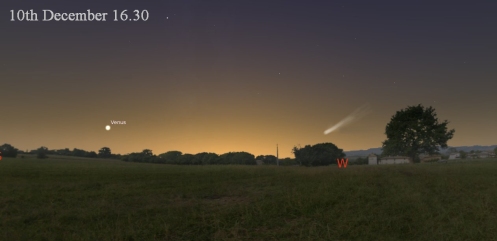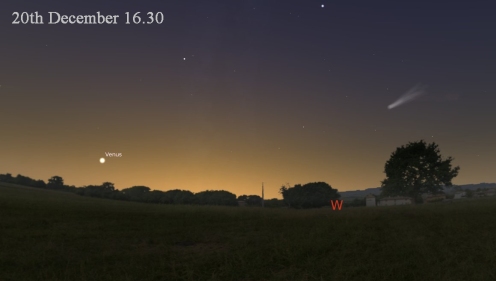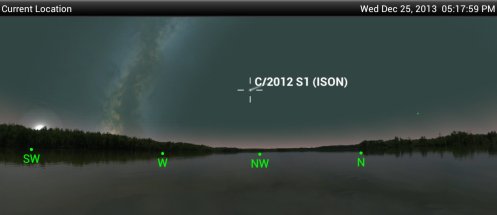DECEMBER 2013
VERY IMPORTANT NOTE: These charts are drawn for what is commonly called “mid Northern latitudes”, i.e. the UK, northern Europe and most of the US. If you live outside of that area your opportunities to view ISON will be different. To find out if you can see ISON from where YOU live, please go to this page of my blog…
https://waitingforison.wordpress.com/can-i-see-comet-ison-from-where-i-live/
…where you’ll find a fantastic NASA chart giving general guidance, and a number of charts I’ve made showing the comet’s visibility from other places, specifically India, Japan and The Philipines, which are the places I’m getting the most enquiries from. If you’re still not sure about your ability to see ISON after reading all that, I strongly suggest that you download one of the many available astronomy apps onto your phone, which will tell you exactly what you want to know. I recommend some of those on this page of my blog…
https://waitingforison.wordpress.com/ison-publications-and-apps/
Thanks – and good luck with ISON!
—————————————————————————————————————————————————-
UPDATE: 20th NOVEMBER 2013
There are a LOT of charts on this page, and all of them will be useful to you one way or another, I hope. But I’m aware that some of you visiting here just want a very quick “Where is it? SHOW me!!” guide to where to find the comet, so I’ve come up with some extremely simple charts for you! I hope you’ll scroll down the page and see the others, too, but in the meantime these should help you until month’s end.
Dec 1st: Having rounded the Sun what will ISON do? What will it look like? Will it have an amazing, beautiful tail? We can’t know yet. But we know where it will BE – in the east, before dawn. On Dec 1st it will lie to the left of the very thin crescent Moon (size exaggerated on this next pic to show where it is), Mars and Mercury.
Dec 3rd: As December gets into its stride ISON could be a striking sight in the pre-dawn sky, we just don’t know yet…
Dec 5th: By now it should be worth looking for Comet ISON in the western sky after sunset, too. On the 5th it will lie to the right of the lovely crescent Moon and brilliant Venus. It might still be hard to see against the bright twilight tho…
Dec 5th: earlier that morning ISON will be easier to see, standing above the eastern horizon with its tail – if it has one – pointing almost straight up.
Dec 10th: Definitely worth looking for ISON after sunset now, even though the sky will still be bright and the tail will only make a shallow angle with the horizon…
Dec 13th: ISON **could** be a striking sight in the western sky after sunset now, we’ll have to wait and see, but here is where to look for it, whatever it does…
Earlier that morning ISON will be much easier to see in the east before dawn, with its tail – if it has one – pointing straight up from the horizon…
Dec 20th: ISON higher after sunset by now but probably fading a lot too…
Dec 25th – at the end of Christmas Day, look for Comet ISON in the north late in the evening, its tail pointing up towards thestars of the Big Dipper…
Dec 25th: before dawn on Christmas Day Comet ISON will be well clear of the eastern horizon, above and between the bright stars Vega and Arcturus.
=====================================================================================
FINDER CHARTS FOR DECEMBER 2013
During December 2013 we should be able to see Comet ISON in both the morning *and* the evening sky. I’m not going to show very detailed, or very many, finder charts for December, because hopeffully it won’t take much “finding”. If you’re looking for it in the morning sky before month’s end you’ll just have to go out, look east before sunrise, and you should see the comet and its tail glowing in the sky right ahead of you. After sunset, just look to the west, or the north-west, and you’ll see the comet shining above the horizon in that direction.
Actually, there’s a slim chance that we will be able to see the comet’s tail, or at least the end of it, ALL NIGHT if ISON really puts on a show. If ISON develops a really – and I mean REALLY – long tail, even after the head of the comet sets in the west we might, MIGHT see the end of the tail still sticking up above the horizon, sweeping across the northern sky as the hours pass until the comet’s head reappears above the easterm horizon before dawn. But that’s a long shot so don’t bet on it, and certainly don’t say I said it would happen! 🙂
How BRIGHT ISON will be as December passes, and how LONG that tail will be, are anyone’s guess, but it’s futile (if fun!) to speculate on that yet. Just hope for clear weather in December and plan to be out comet-watching every chance you get, because by December ISON will be heading away from the Sun again and returning to the icy depths of space.
Ok, so at the start of the month, getting up very early and looking east, the tail could be stretching up towards The Big Dipper…
Sungrazers are usually brighter and more active after they’ve raced around the Sun, and many experts are hoping that ISON will be no different, crossing their fingers that it develops a long, long tail, and a broad one too. As December begins, will it look like Comet Lovejoy (below, left) or Comet West (centre) or Comet McNaught (right)? I can’t wait to find out…!
Whatever it looks like in December, hopefully by then we’ll all have some magical memories of it to look back on in the years ahead.
So, on December mornings, we’ll be going out, looking east, and hoping to see something beautiful. But I think more people will see it after dark in December, just because they’ll already be up and about, so I’m going to concentrate on how and where to see ISON after sunset during the month. But I’ll draw your attention to the view on the morning of December 17th, when ISON will have some very welcome and familiar company in the slowly brightening sky…
Now, the evening sky…
Below: December 6th, after sunset… ooh look, the Moon and Venus close together nearby too… photo time…!
A little later on the same night… by 6pm the Moon should be displaying some lovely Earthshine…
Below: the next day, Dec 7th, just after sunset… the Moon and Venus have moved apart a little, and the comet is a little higher in the sky…
…and again, a little later on the same evening…
Below: December 8th after sunset…
At this time the comet will be a little higher in the sky each night after sunset. This is when it is hoped its tail might really start to develop and become impressive. If that’s the case then as I said already, no-one will have to ‘find’ the comet, they’ll just need to go outside, look to the west, and there it will be… maybe looking something like this…?… (my own artwork, could be right, could be wrong, we’ll see!)
..or maybe even, dare we dream, it might look like this..?
…or maybe a LOT less impressive than that. As I keep saying, we’ll have to wait and see…
By mid month (below: Dec 15th) the comet will be here after sunset, with Venus bright off to its left…
By December 20th, and with Christmas approaching, the comet will be quite high in the NW after darkness falls, heading towards the familiar stars of The Plough…
And don’t forget it will be visible in the morning sky too: by December 22nd the Comet will be close to the globular star cluster M13 in Hercules… telephoto lenses at theb ready, everyone!
On the 23rd (below) the comet will be here before sunrise, sharing the sky (again) with planets and the Moon…
By teatime on Christmas Eve (below) the comet will be high in the NW, and as darkness falls we’ll see it’s getting close to The Plough – and by now, I’m pretty sure it will be so close to the Pole Star that IT WON’T SET AS SEEN FROM THE UK AND MID-NORTHERN LATITUDES. That means that you’ll be able to see it shining in the NW after sunset, follow it all night as it appears to wheel around the Pole Star, and it will still be in the sky at sunrise…
At the end of Christmas Day 2013, by the time all the wrapping paper is scrunched up and stuffed into bin bags, and the family are fast asleep and snoring in their chairs, ready to be woken up for the Dr Who Christmas Special (if there IS one, there’d better be!!!), the comet will be high in the NW after sunset…
…and by midnight, we’ll be looking at it here…
Can’t wait to take photographs of the comet that night…!
As Christmas fades away behind us, Comet ISON should still be a splendid sight in the sky after dark and all through the night, never setting, so you will be able to spend literally all night gazing at it and photographing it if you wish! Early risers on the morning of the 27th will be rewarded with a fantastic view… the Comet pointing towards the stars of the Plough, with Saturn, the crescent Moon and Mars all shining beneath it above the eastern horizon…
Please, pleeeeeeeeeeeeeeeeeeeeeeease don’t let it be cloudy that morning!!!
…and then, before we know it, December will be almost over, and 2014 will be on our horizon. What memories will we have of ISON by then? How will it look in our sky still? As we all prepare to see in the New Year at midnight on Dec 31st 2013, will Comet ISON, now heading away from Earth, the best of its encounter behind it, and behind us, will it be a prominent naked eye object, or will it need binoculars to be seen properly? Whatever it looks like, here is where you’ll find it – high in the north, edging up towards the Pole Star…
And then, January 2014…






























happy new year 2014
thanks